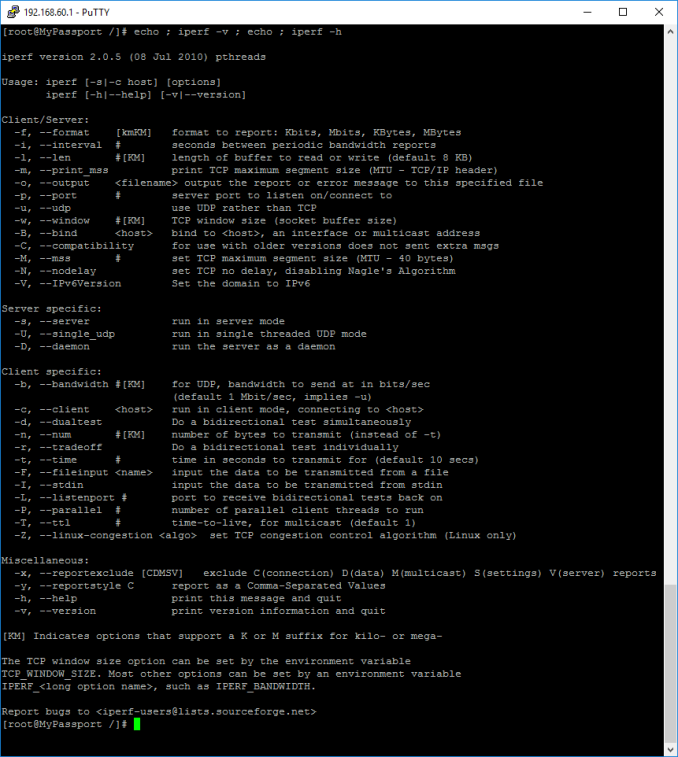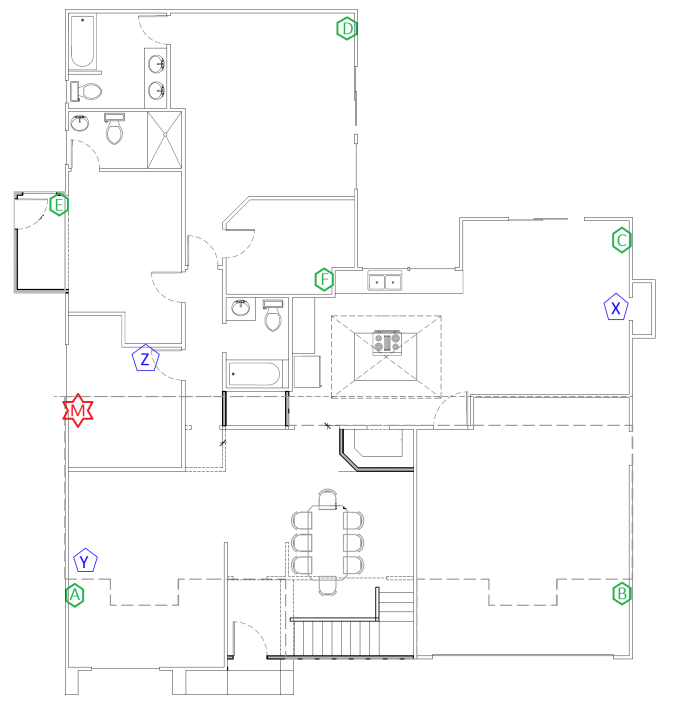Western Digital My Passport Wireless Pro Wi-Fi Hard Drive Review
by Ganesh T S on June 21, 2016 8:08 AM EST- Posted in
- Storage
- Western Digital
- Gadgets
- wireless storage
Wireless Benchmarks
Our review of the My Passport Wireless loaded up video files of varying bitrates into the device and tried to stream them to various devices to determine the effectiveness of the WLAN component. The range factor was addressed using a W-Fi strength analyzer app on a smartphone. The My Passport Wireless Pro makes it necessary for us to adopt a different strategy, as the dual-band aspect also deserves attention. Fortunately, the SSH access and software capabilities of the My Passport Wireless Pro allows us to utilize iperf for benchmarking the Wi-Fi capabilities. The OS running on the unit ships with iperf v2.0.5 pre-installed.
Two of the striking differences in the WLAN specifications of the My Passport Wireless and the Pro are the presence of a 5 GHz 802.11ac radio in the latter and the downgrade from a 2T2R 2.4 GHz 802.11n solution in the former to a 1T1R one in the Pro. Western Digital indicated that they are targeting the My Passport Wireless Pro for high-performance applications in close-range scenarios, and the 2.4 GHz band is retained only for legacy reasons.
Our evaluation strategy consists of using iperf to determine TCP and UDP downlink and uplink rates at three different locations (marked X, Y and Z in blue) in a 1800 sq. ft. home, as indicated below. While the My Passport Wireless Pro (set up at location M in the floorplan) was set as the server node, an Intel D54250WYKH NUC running Windows 10 Pro x64 was used as the client at the three different locations. The NUC sports an Intel Dual Band Wireless-AC 7260 2T2R 802.11ac solution.
The purpose of our benchmarking was not to tune the stream configuration for obtaining maximum possible bandwidth. Rather, we wanted to replay the same stream across multiple locations in order to determine comparative performance. iperf with default parameters was used for benchmarking. On the 'server', we ran the following command:
TCP: iperf -s -B 192.168.60.1
UDP: iperf -s -u -B 192.168.60.1
The 'client' was connected to it using the following command:
TCP: iperf -c 192.168.60.1 -P ${num_parallel_streams} -t 30
UDP: iperf -c 192.168.60.1 -u -b ${curr_bw_to_test}m -t 30
The number of parallel streams were tested between 20 and 25 for the TCP case. The maximum obtained bandwidth was recorded. For the UDP case, we altered the bandwidth to test in order to arrive at the value that resulted in less than 1% packet loss during transmission. The roles of the server and client were then reversed, and the same benchmarks were processed.
The numbers below were recorded with the unit in standalone wireless NAS mode. Using it as a Wi-Fi access point with uplink in the same band as the usage band is bound to bring down the numbers even further.4
| Western Digital My Passport Wireless Pro 2TB WLAN Benchmarks (Mbps) | ||||||||
| 2.4 GHz SSID | 5 GHz SSID | |||||||
| TCP DL | TCP UL | UDP DL | UDP UL | TCP DL | TCP UL | UDP DL | UDP UL | |
| Location X | 9.82 | 14.3 | 9.17 | 17.2 | SSID Not Visible | |||
| Location Y | 33.7 | 26.6 | 34.8 | 32.8 | 37.3 | 5.32 | 37.5 | 8.19 |
| Location Z | 80.9 | 67.7 | 84.3 | 75.4 | 183 | 114 | 197 | 126 |
Wi-Fi numbers are heavily dependent on the usage environment, and the only takeaways we have from the above are the fact that the 5 GHz SSID is handicapped by range issues, but, it outperforms the 2.4 GHz SSID when it comes to same-room usage (which is the typical use-case for the My Passport Wireless Pro). The hard drive or attached storage media access rates are unlikely to the source of bottlenecks when it comes to real-world data transfers involving the unit.












25 Comments
View All Comments
jabber - Tuesday, June 21, 2016 - link
Oh wow! Does this mean that WD have ditched that totally unnecessary custom SATA connector in the Passport series for good? Have always told customers to avoid those for that reason.Michael Bay - Tuesday, June 21, 2016 - link
I have two USB3 Passport models, and neither has anything over standard USB3 port.jabber - Tuesday, June 21, 2016 - link
No I meant inside the caddy. If you open them up the HDD doesnt have a standard SATA connector. It is wired directly to the USB port or uses a odd connector wired to the USB. So the caddy/USB part can fail but you cant then slot the bare drive in a dock and copy the data off. Not very clever.Michael Bay - Tuesday, June 21, 2016 - link
Oh. I hope I don`t have to pry those open.jabber - Tuesday, June 21, 2016 - link
Yeah keep your fingers crossed on that one. ooer!Goodspike - Tuesday, June 21, 2016 - link
Maybe I missed it, but can you log into your existing wireless network with this device, such that it would just be a network drive either in a more secure location (basically anything not connected to by a cord to a computer someone might steal) or one that just didn't require a cable to connect the device for aesthetics?ganeshts - Tuesday, June 21, 2016 - link
Yes, in the access point mode, it can have an uplink to a different network via Wi-Fi. On that network, it just appears like a wireless NAS. Devices connected on the primary network can access the MPW Pro just like any other NAS with CIFS shares.soliloquist - Tuesday, June 21, 2016 - link
My experience with WD MyCloud products has been mostly positive. They are easy to setup and basically function as intended. My only gripe is when accessing the MyCloud from outside your local network with the app (either desktop or mobile). Doing so for consumption purposes is not a problem, but if you want to copy numerous files to a remote location it is not efficient. The ability to drag and drop to a remote desktop through the app would be more ideal.mr_tawan - Wednesday, June 22, 2016 - link
I have a Passport Wireless and I'd say I'm unimpressed. Originally I planned to use it as a portable NAS as well as a wireless bridge. The NAS-side of the thing seems to be acceptable, but the wireless bridge side leave a lot to desire. I find that it could not find a wireless router located 2 metres away, which render it totally useless in this regard.It ends up as a portable SD card backup storage, in my case.
marvdmartian - Wednesday, June 22, 2016 - link
Personally, I'd rather see this offered as a bare bones model (no hdd or ssd) that I can place MY drive into. That way, if you already have a drive laying around (as I bet some of us do), and would rather not pay for WD's drive. At the retail price we're seeing for the 2.5TB drive ($230), I could see them offering the bare bones drive for ~$125-$150.